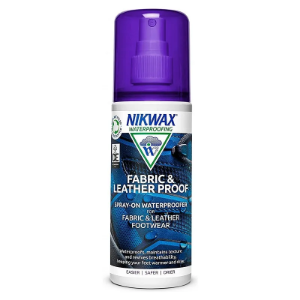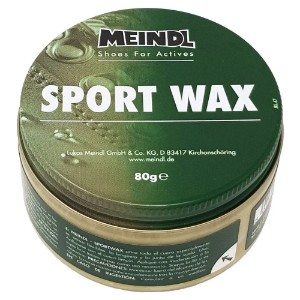Cleaning and Proofing
Everything and everyone benefits from a bit of TLC and your outdoor footwear should be high on your priority list.
Why?
We get plenty of customers that assume that as their footwear are classed as waterproof, i.e. they have a waterproof membrane, they don't have to do any upkeep for them to continue functioning. And whilst the waterproof membrane shouldn't leak unless you perforate it with a stone, toenail, etc. the outer of the boot or shoe does need to be regularly re-treated to stop it soaking up moisture. This moisture will be from the outdoors so it will be dirty and where there is dirt there will be bacteria. If the outer part of your footwear is soaking up any moisture this and the dirt and bacteria will sit in the outer fabrics gradually eating at and rotting them. Not only that every step you take will be pushing that moisture throughout the outer of the boot or shoe and over the top and in some cases through the midsole to make it seem like your boots are leaking. So as soon as you notice that moisture doesn't bead on the surface, i.e. it soaks in, then its time to give them some attention. How regularly this will be necessary will vary depending on how regularly and how far you walk, where you walk (long wet grass is about as bad as gets, seemingly saturating boot outers quicker than standing in a bog), what weather you go out in and will happen more rapidly with some construction and materials of footwear than others and with different types of treatment used.
Cleaning
We recommend specific footwear cleaning brushes as they are the correct stiffness to remove dirt but won't damage the footwear. Our favourite is the MudMate Boot Cleaner as it doesn't require a bucket of water or a hose (though you can use it with a hose if you have a large families worth of boots to clean) so uses very little water and keeps the area of mess very compact. The most recent model also has a bit for removing stones from between the tread on the soles of your boots.
Proofing
Different boot materials work best with different treatments and proofants but may also benefit from other options at different times during their lives. For example boots that have had a lot of recent wetting and drying will benfit from conditioning as well as pure waterproofing. the following are our recommendations based on many years experience and the latest advice from the manufacturers themselves.
Full Grain Leather: shiny outer leather is the most waterproof (tightest grained) version of leather and therefore requires the least regular looking after. It wipes clean very easily and you can apply very resilient wax easily by hand. We recommend a brush for cleaning them, wax for reproofing (e.g. Zamberlan Hydrobloc or Grangers G-Wax) and returning their shine and an occassional conditioning wax (e.g. Meindl Sport Wax) as your footwear may become dried out from repeated soakings and is particularly relevant to the forefoot areas where the boot or shoe is required to flex the most and succums to the largest amount of abraision.
Nubuck Leather: nubuck is full grain leather that has been sanded to give a slightly softer, more forgiving feel and increased breathability over full grain leather. It also has the advantage that manufacturers can more easily impregnate their leather with nourishing oils. It's rougher surface compared to full grain leather will mean that it will hang onto dirt more readily making it slightly harder to wipe clean. We recommend a brush to clean nubuck leather, a gel to remove ingrained dirt (e.g. Nikwax Footwear Cleaning Gel) and a spray that will provide a waterproof cover. Because of the leathers more open nature it does need nourishing more regularly than full grain leather so we recommend a conditioning wax (Meindl Sport Wax) for the whole of the boot used at more regular intervals with a spray coat over the top of this (e.g. Meindl Wet Proof).
Nubuck Leather with a Waterproof Membrane Liner: whilst on the face of things there isn't a great deal of difference between this type of footwear and standard nubuck leather footwear we do find that it is more important to maximize breathability rather than providing the out and out waterproofing that you need for a non-membraned boot. We recommend a cleaning brush, a gel to remove ingrained dirt and a spray on waterproofing and conditioner combination (e.g. Meindl Conditioner and Proofer). This means that this is the first option that doesn't require applying wax by hand - meaning no waterproof fingers for you. You will find that you have to do it more regularly than with a wax treatment and that the treatment doesn't go as far in terms of distance walked or number of treatments. A tin or tube of wax can last some walkers years, whilst a spray may only do a handful of applications.
Suede Leather, Fabric and Suede/Fabric combinations: suede is the softest most open part of leather (the inner part that isn't exposed to the weather) and as such provides the least amount of water-repellancy and durability of all the leathers. Fabrics such as polyester and nylon are woven and as such are rougher than full grain leather so also hold onto dirt more readily and abraide quicker than full grain leather. In high end versions such boots can be lighter and more breathable, in budget versions they may well be more durable but are often heavy and have very little breathability. The varied layers of material on these boots make them the hardest to clean and require the most regular reproofing. We recommend a cleaning brush, a gel to remove ingrained dirt and a spray on waterproofing and conditioning combination (e.g. Grangers Footwear Repel Plus). We have tested some of these boots and found that they could have done with a treatment prior to their first walk if its a long and boggy one.
Still unsure which options to go for then we have made up boot and shoe care kits specific to the types of footwear described above, they also make a great present for the walker in your life.
As noted above, long wet grass is a monster for wearing away water-repellant treatments, saturating boots and getting everything wet. As well as regularly reproofing your boots if you walk a lot in such places we also recommend giving your shoes/boots, socks and trousers some help and protection by wearing gaiters.
Nikwax
Fabric & Leather Proof
The Nikwax Fabric & Leather Proof is designed to maintain the appearance, waterproofing and breathability of leather and fabric footwear. It is best used with Nikwax's Footwear cleaning gel (otherwise you're waterproofing the dirt on the surface of your boots!). Nikwax products do not contain PFCs, which are chemicals that are good at making things water repellent but are also harmful to the environment.
Meindl
Sport Wax
Meindl SportWax has been specifically designed for use with nubuck leather. It will help to condition and keep the leather supple, in turn preventing it from cracking or drying. The leather will lose the brushed nubuck effect and darken, but treatment will improve water-resistance. Water-resistance will be further improved with the use of Wet Proof, particularly in soft leather areas, e.g. the tongue gusset on the Meindl Borneo.


